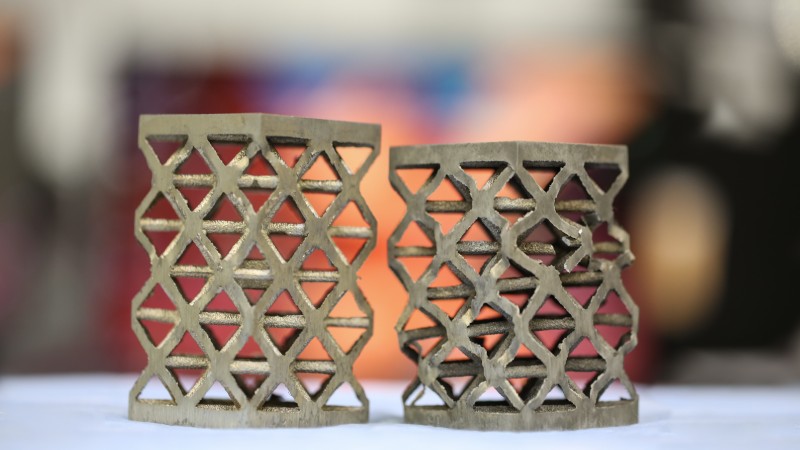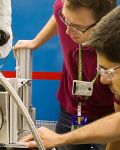Researchers from Virginia Tech University are using neutrons at the Department of Energy’s (DOE’s) Oak Ridge National Laboratory (ORNL) to study cast aluminum lattice structures produced at lower cost by using 3D printed sand molds combined with traditional foundry melting and pouring techniques. Lattice castings have excellent energy absorbing properties that can be useful in life-saving applications such as crash protection in crumple zones and doors of vehicles, earthquake-resistant pads for building foundations, blast-resistant walls for buildings, and other applications requiring lightweight energy absorption. Neutron scattering is ideal for examining the quality of the lattice features and their behavior under loads, because neutrons can penetrate the two- and three-inch-thick cast aluminum samples, and reveal their geometrically complex features, better than other methods.
In addition to evaluating casting quality, the researchers are obtaining data to help validate a software model for predicting the energy absorbing behavior of lattice castings in various conditions. The model could speed up the development of new casting designs for a wide range of applications.
“We’re employing 3D printing to push the limits of how small our lattice features—the trusses—can be made using sand molds,” said Alan Druschitz, associate professor at Virginia Tech and director of the school’s Foundry Institute for Research and Education. “3D printing, also known as ‘additive manufacturing,’ is helping a centuries-old technology—sand mold casting—find use in making advanced parts for high-tech applications. Plus, using CAD [computer-aided design], we can now design and modify a casting mold in a few hours, where previously it would have taken weeks or months, if these molds could have been made at all.”
Druschitz says that by using additive manufacturing to build sand molds, his team reduced the dimensions of the trusses to the thickness of wires. “The advantages of using small-diameter aluminum lattice features is that we can achieve high strength, stable deformation, and lighter weight, which in most applications are desirable properties,” he added.
The research was conducted using the polychromatic cold neutron beamline (CG-1D) at ORNL’s High Flux Isotope Reactor (HFIR)—a DOE Office of Science User facility—where the scientists took approximately 1,200 images for every 3D data file they created. Before imaging, they partially deformed, or crushed, some of the samples to help determine how the various geometries react to loading forces. Some of the samples included an embedded ceramic tile to help the lattice structures resist penetrating objects, such as bullets and shrapnel.
Assisting in the experiments at HFIR was Daniel Ching, a senior at Virginia Tech, who is designing and producing variations on aluminum lattice structures as part of his senior year project. “I really enjoy this area of research, because it brings together mechanical engineering, modeling, and materials science,” said Ching. “It also provides opportunities to learn about neutron research and network at two leading neutron sources, the Spallation Neutron Source and HFIR.”
The researchers say their next steps will include working with different metals, employing other types of structures, and using neutrons to determine exactly what the loading forces are on each feature. Varying the thickness of the lattice structure, and omitting or adding features, are also planned to help optimize designs and performance metrics for specific applications.
“Ultimately, the benefit of using 3D printed sand molds to make our castings is the potential cost savings. All you need are CAD files and a 3D printer to make the sand molds, so there are no tooling costs, and design changes are fast and easy—with a lead time of just days. We’re seeing a lot of interest by industry and the government, including the National Science Foundation, which supported our early work, and the Defense Logistics Agency, which recently approved an award of $525,000 to help fund our work as part of their Innovative Casting Technologies program,” said Druschitz.
HFIR and the Spallation Neutron Source are DOE Office of Science User Facilities. UT-Battelle manages ORNL for the DOE’s Office of Science. The Office of Science is the single largest supporter of basic research in the physical sciences in the United States and is working to address some of the most pressing challenges of our time. For more information, please visit https://science.energy.gov/.—by Paul Boisvert
Aricle originally published in Neutron News.






